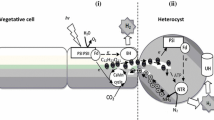Abstract
The activity of hydrogenase in intact cells of the unicellular cyanobacterium Cyanothece PCC 7822 was investigated using a mass spectrometer with a permeable membrane inlet. A small hydrogenase-catalyzed hydrogen production was observed with nitrate-grown cells under anoxic conditions in the dark. The same cells were also capable of a much greater rate of hydrogen uptake, induced by oxygen as well as light. Light-induced hydrogen uptake was inhibited by uncoupler. In contrast, addition of uncoupler caused a four-fold stimulation of anoxic hydrogen production in the dark. It is suggested that anoxic hydrogen production is the result of fermentative metabolism.
Cyanobacteria are generally considered to have at least two distinct hydrogenases (Houchins 1984). One is a membrane-bound uptake hydrogenase which appears to be associated with nitrogen fixation, removing the hydrogen produced by nitrogenase with the concomitant production of reductant or ATP (Eisbrenner et al. 1978). The second is a reversible hydrogenase located in the cytoplasm and not closely linked to nitrogen metabolism. The reversible character of this enzyme can be demonstrated in the presence of suitable electron donors or acceptors; hydrogen consumption and evolution occur at similar rates (Lambert and Smith 1980).
A reversible hydrogenase capable of reducing protons with the artificial electron donor couple dithionite and methyl viologen is widely distributed amongst cyanobacteria. However its physiological role remains unclear. The enzyme appears to be sensitive to oxygen, and consequently in vivo activity can only be demonstrated under anoxic conditions (Houchins 1984).
On the basis of in vivo measurements with tritium and the observed low K m for hydrogen, the function of the reversible hydrogenase of the heterocystous cyanobacterium Anabaena has been proposed to be the uptake of hydrogen as a means of collecting additional reducing power during growth in light-limited anoxic environments (Spiller et al. 1983; Houchins 1984). However, Hallenbeck et al. (1981) reported a modest production of hydrogen by intact filaments of Anabaena.
An example of a function of the reversible hydrogenase in the production of hydrogen is provided by the nonheterocystous filamentous cyanobacterium Oscillatoria limnetica. This organism is capable of shifting between oxygenic and anoxygenic photosynthesis (Oren and Padan 1978). In the latter case sulfide is the electron donor supporting photoreduction of CO2 via photosystem I only. However when CO2 is limiting, excess reducing equivalents are removed by a reversible hydrogenase (Belkin and Padan 1978). This hydrogen production probably enables the organism to continue photophosphorylation under these conditions.
We recently reported that the unicellular cyanobacterium Cyanothece 7822 is capable of hydrogenase-catalyzed hydrogen production in vivo, without the addition of artificial reductants (Van der Oost et al. 1987). In this paper we have investigated the in vivo activity of the hydrogenase in Cyanothece by monitoring the concentrations of dissolved H2 and O2 in the cell suspension using a mass spectrometer with a permeable membrane inlet.
Similar content being viewed by others
Abbreviations
- DBMIB:
-
2,5-dibromo-3-methyl-6-isopropyl-p-benzoquinone
- DCMU:
-
N-(3,4-dichlorophenyl) N,N-dimethylurea
- FCCP:
-
carbonylcyanide-p-trifluoromethoxy phenylhydrazone
- PBQ:
-
phenyl benzoquinone
References
Belkin S, Padan E (1978) Sulfide-dependent hydrogen evolution in the cyanobacterium Oscillatoria limnetica. FEBS Letters 94:291–294
Degn H, Lundsgaard JC, Petersen LC, Ormicki A (1980) Polarographic measurements of steady-state kinetics of oxygen uptake by biochemical samples. Meth Biochem Anal 26:47–77
Degn H, Cox RP, Lloyd D (1985) Continous measurement of dissolved gasses in biochemical systems with the quadrupole mass spectrometer. Meth Biochem Anal 31:165–194
Eisbrenner G, Distler E, Floener L, Bothe H (1978) The occurrence of the hydrogenase in some blue-green algae. Arch Microbiol 118:177–184
Hallenbeck PC, Kochian LV, Benemann JR (1981) Hydrogen evolution catalyzed by hydrogenase in cultures of cyanobacteria. Z Naturforsch 36c:87–92
Houchins JP (1984) The physiology and biochemistry of the hydrogen metabolism in cyanobacteria. Biochim Biophys Acta 768:227–255
Izawa S (1977) Inhibitors of electron transport. In: Trebst A, Avron M (eds) Encyclopedia of plant physiology, new series, vol 5. Springer, Berlin Heidelberg New York, pp 266–282
Jensen BB, Cox RP (1983) Direct measurements of steady-state kinetics of cyanobacterial N2 uptake by membrane-leak mass spectrometry and comparison between nitrogen fixation and acetylene reduction. Appl Environm Microbiol 45:1331–1337
Jensen BB, Cox RP (1988) Mass spectrometric measurements of hydrogen exchange and nitrogen uptake. Methods Enzymol 167:467–474
Lambert GR, Smith GD (1980) Hydrogen metabolism by filamentous cyanobacteria. Arch Biochem Biophys 205:36–50
MacKinney G (1941) Absorption of light by chlorophyll solutions. J Biol Chem 140:315–322
Oren A, Padan E (1978) Induction of anaerobic, photoautotrophic growth in the cyanobacterium Oscillatoria limnetica. J Bacteriol 133:558–563
Rippka R, Kllas T (1985) Activities of nitrogenase and hydrogenase in unicellular nitrogen fixing cyanobacteria. In: Abstracts of the Fifth International Symposium on Photosynthetic Prokaryotes, Grindelwald, Swiss, p 61
Rippka R, Duruelles J, Waterbury JB, Herdman M, Stanier RY (1979) Genetic assignments, strain histories and properties of pure cultures of cyanobacteria. J Gen Microbiol 111:1–61
Spiller H, Bookjans G, Shanmugam KT (1983) Regulation of hydrogenase activity in vegetative cells of Anabaena variabilis. J Bacteriol 155:129–137
Van der Oost J, Kanneworff WA, Krab K, Kraayenhof R (1987) Hydrogen metabolism of three unicellular nitrogen-fixing cyanobacteria. FEMS Microbiol Lett 48:41–45
Author information
Authors and Affiliations
Rights and permissions
About this article
Cite this article
van der Oost, J., Cox, R.P. Hydrogenase activity in nitrate-grown cells of the unicellular cyanobacterium Cyanothece PCC 7822. Arch. Microbiol. 151, 40–43 (1988). https://doi.org/10.1007/BF00444666
Received:
Accepted:
Issue Date:
DOI: https://doi.org/10.1007/BF00444666




